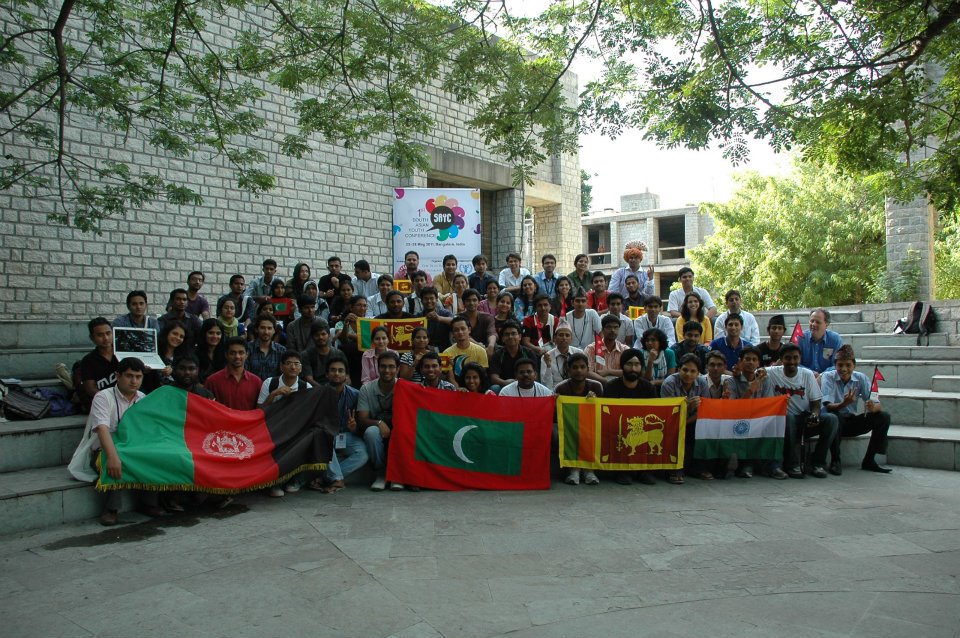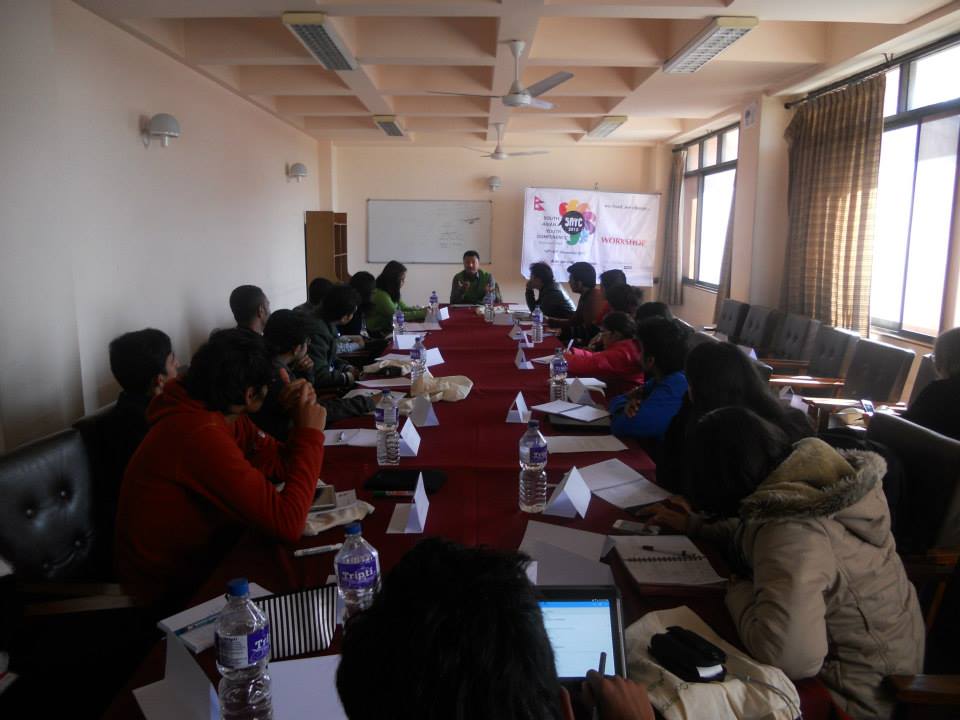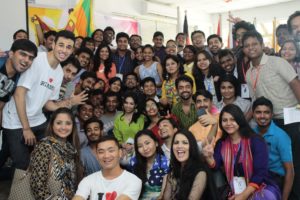The Blue Ribbon Movement is an ecosystem of social initiatives building leadership for a better world. It conceptualized the South Asian Youth Conference (SAYC) in 2011.
SAYC held its first conference in IIM-Bangalore, India, with a theme of Peace, as expressed in three levels: peace within, within people and with the environment. The idea was to look at peace not as an absence of conflict but as an actual process in relationships. Inactivity and inertia were seen not as substitutes for peace. Instead, active effort was required to achieve real peace and harmony.
The conference brought together 110 delegates from India, Pakistan, Bangladesh, Sri Lanka, Afghanistan, Nepal, Bhutan and Maldives. The conference welcomed many distinguished speakers- from His Holiness Sri Sri Ravishankar Ranjan Malik, artist and film-maker, Ms. Nisha Agrawal to David Woollcombe of Peace Child International and Gift Economy practitioner Vinod Sreedhar.
The objectives of the conference drew from the broader objectives of SAARC and the UN, and were implemented along these lines:
- Developing a global partnership for development (UN Millennium Development Goal #8 and SAARC founding objectives);
- Fostering an eco-system of youth-led development;
- Create actionable projects and agenda
His Holiness, the Dalai Lama’s message to SAYC 2011: “Young people today have the opportunities and the resources , as well as the responsibility to make this 21st century an era of peace and dialogue”
2012:
In 2012, the SAYC conference moved from India to Islamabad, Pakistan. HILA Pakistan, the National Lead Organizer, along with the Blue Ribbon Movement took the conference to the next level. Describe HILA in 1 line.
SAYC 2012 witnessed the birth of the South Asian Youth Coalition – a group of youth organizations committed to building a stronger region. The SAYC thus becomes a focal point for these highly influential change-makers to connect, collaborate and build connections.
The theme of the SAYC 2012 centered on Youth and Peace, Youth and Education and Youth and Sustainable Development. The universal problem of scarcity and the rapid development is a threat to the scarce resources of the South Asian region and is ultimately a hazard for the future generations to come.
One important outcome of the conference was the consensus of the 96 delegates to create the ABCD- Action Based Change Declaration- which highlights the steps youth and government have to take to address current socio-political, environmental and development issues. The Chief Catalyst of the Blue Ribbon Movement, Abhishek Thakore, presented the declaration at the United Nations in New York on November, 2011.
The ministers in attendance at SAYC 2012 included Hina Rabbani Khar, 26th Foreign Minister of Pakistan and Faisal Sabzwari, Minister for Youth Affairs Sindh.
2013:
The third edition of the SAYC was held in Kathmandu, Nepal in December 2013. The conference, jointly organized by The Association of Youth Organisations Nepal (AYON), and The Blue Ribbon Movement, India (BRM), brought together talented, enthusiastic leaders along with observers from Malaysia and Germany. Approximately 70 youth leaders from all South Asian countries attended and participated in comprise?? action projects, skill-building workshops, speaker sessions, debates, screening of the documentaries, dialogue, and cultural exchange. The conference included the themes of livelihood development, meaningful participation, and sustainability.
The Association of Youth Organization Nepal (AYON) and the licensee from BRM, (we – BRM – are the licensee of SAYC ) were established as the working committee’s national secretariat. Likewise, an international organization working with youth across the world and with UN agreed to support the conference design and speakers.
The ministers that attended the conference include Honorable Khil Raj Regni, Former Prime Minister of Nepal, and Mr. Ram Kumar Shreshtha, Honorable Minister of Youth, Nepal.
2014:
South Asian Youth Conference was a unique example in organising online. The event was a great success with more than 50 participants joining various sessions throughout the day from even far off locations such as Swat Valley in Pakistan. Apart from keeping the South Asian movement alive, it set an example in how technology can enable a coming together of various grassroots movements without much resources. From gender to security issues, SAYC 2014 created conversations around various topics. The online events were complimented by various offline, decentralised events which people enthusiastically organised in the spirit of solidarity and contribution to the larger South Asian movement.
2015:
The 5th South Asian Youth Conference, organised from 11-15th December 2015, concluded successfully at the Horizon Campus, Malabe, Colombo – Sri Lanka. SAYC 2015 brought together 77 participants from 8 South Asian countries and 3 observer countries for a diverse cultural experience and to deepen the understanding of South Asian issues.
Read the full report here.
2016:
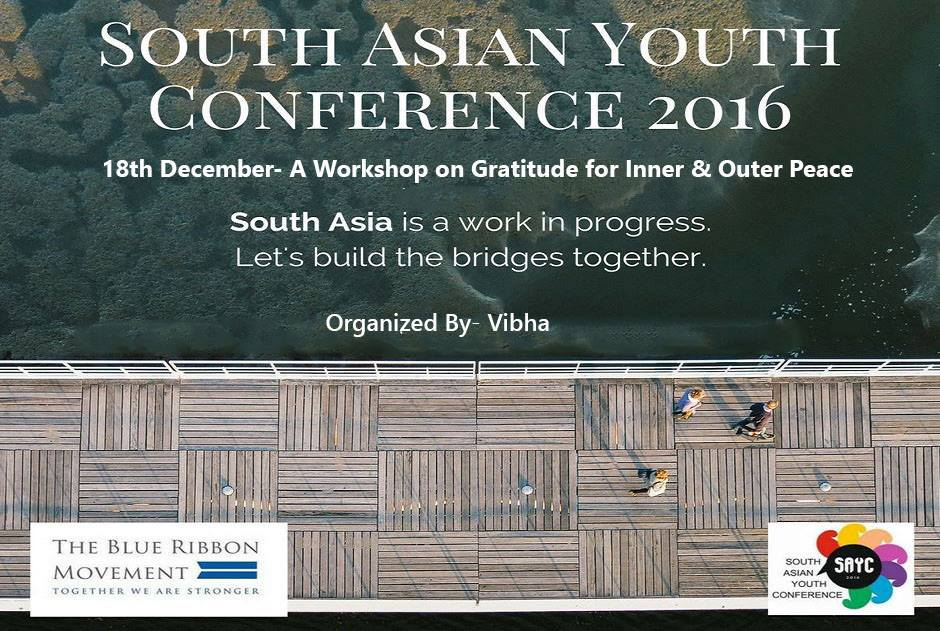
SAYC 2016 was an online-offline event taking place all over South Asia from 16-19th December, with 20th December celebrated as the Day of Solidarity with the rest of the world. There were different topics like the situation of LGBT community in South Asia, Pathways to Peace in Kashmir: a dialogue and many such interesting themes.
2017:
The South Asian Youth Conference (SAYC) Kabul 2017, was a three-day event, which was designed to be dynamic, positive space where 100 plus youth delegates from across
South Asia could interact and exchange mutually-beneficial ideas. It was a platform to allow the youth to showcase and express fruitful cooperation and coordination in promoting peace, equal rights for all, culture and diversity through art and end to all kinds of violence against youth.
All thematic days included workshops, panel discussions, guest speakers and working-groups to cover centric themes of:
1) Art and culture;
2) Gender mainstreaming and its interpretations in South Asian context;
3) Violence and youth.
The three days were packed with different activities from morning exercises, to the impactful reflections, panel discussions, and interactive workshops. The workshops included topics like Art & Tolerance, Mughal Art in South Asia, Cinema & Future Collaboration in South Asia, 50 years of Film & Cinema; “Meeting the violence within me”; Music Against Violence, Afghanistan Needs you, Gender programs in India lesson learned and challenges; and Youth and Violence in India. Besides the workshops and panel discussion, the conference included Mural painting, Kite Flying, Afghan Pop Music, Cultural nights, Exhibition of Afghan Handicrafts and pottery from various part of Afghanistan, Handmade Jewelry by Afghan Designer, traditional Afghan street food and so much more.
Read the final communique here.
2018:
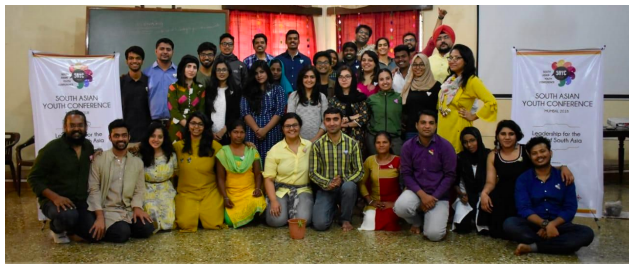
The Blue Ribbon Movement hosted the 8th Edition of the South Asian Youth
Conference from 13th to 17th December, 2018 at Retreat House in Bandra, Mumbai.
The Conference saw 25 delegates from the South Asian countries Nepal, Afghanistan, Sri Lanka, Maldives, and India. The selected Pakistani delegates could not make it due to visa issues. We had them over Skype for some time.
The theme of SAYC 2018 was ‘Leadership for the Future’ of South Asia. There have been several developments in the field of leadership. How do we bring these to create a South Asia that the youth dream of?
Clearly, the existing leadership models have failed us. They have only created more extremism and centralization. Our still-developing countries spend on wars and defense while millions experience hunger and malnutrition. We are preoccupied with what each of us is doing to the other country, rather than strengthening ourselves. This, we believe is a result of a myopic leadership.
In SAYC 2018, we looked at the ways of achieving Peace and Non-violence through the strategy of building new leadership. We are ready with 8 years of building a platform (of alumni, national leading organizations) to create something that will help in the transformation of the region.
Over the 5 days, through workshops and sessions, we focused on developing a sharper understanding of the challenges we face as well as building the skills we need to respond to the crisis.
Link to the SAYC 2018 video : https://youtu.be/C8TAPlHKRSM
Read the full report here
2019:
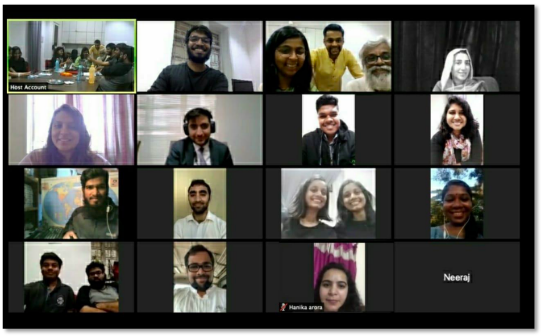
The 2019 SAYC was held online where we pushed ourselves to break away from the geographical boundaries by using the internet constructively to come together. We dreamt to bring to birth a virtual experience of the real future we would want for South Asia; creating a virtual space to listen, connect and share our feelings as children of South Asian beyond our national identities.
This 9th South Asian Youth Conference envisioned to be one of the very few concrete, actionable steps that one could take, as a way to connect to the South Asian region despite geographical barriers.
The conference was streamed live on Zoom – a video conference app, not just for a few hours of the sessions but for 33 hours straight. We took this experiment to build friendships with young people across South Asia who share this similar dream. The participants were among those who genuinely cared, and their showing up translated that care into something beyond words.
This enabled us to experience each other as humans beyond any tags and labels. This setting allowed the participants to know each other as individuals living in different countries. By experiencing our daily lives by sharing online meals together, meeting each other’s family members and seeing how different the localities look. It did create deeper connections as individuals living across borders trying to understand each other and dream of a peaceful South Asia.
Read the full report here
2020:
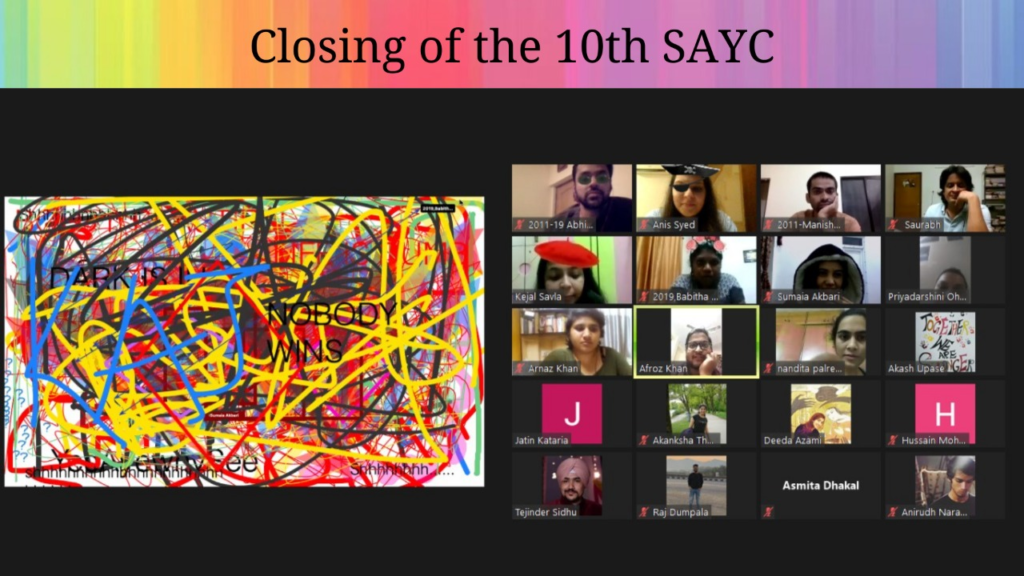
The 10th SAYC was a 2 day Alumni only Conference on 31st Oct and 1st Nov 2020.
During these 2 days, we reconnected with our friends, felt nostalgic about the good old memories of SAYC and co-created the future of SAYC in the form of a co-held commun
Reflections from SAYC 2020
SAYC 2020: DAY 1
Session 1: Alumni spent time reconnecting with their own batch by sharing memories of the conference they attended, catching up on life updates and their whereabouts during the pandemic. We had 40+ Alumni who joined to add their love.
Session 2 we moved onto 10 Open Webinars which were offered by alumni on their topic of expertise and their current work. We had around 60 individuals joining from different countries.
Session 3 was a virtual cultural night co hosted by our Alumni Deeda and Sumaia. The night observed alumni dressed in their traditional attire, welcoming each other in their own local languages. We described the local food delicacies, shared laughter and music from our country. We also had very beautiful shayaris, poems, songs & monologues being shared by creative folks in the room.
SAYC 2020: Day 2
Session 4 and 5 started with sharing our experiences from the previous day and memories from the last 9 years of SAYC. Through the two sessions, we envisioned collectively the future of SAYC.
We shared the current challenges faced by SAYC and what could be possible solutions to it. We held questions like :
- How can we co-create a space that enables youth in South Asia?
- How can we build a close-knit community of people who truly care for South Asia and do not have any external influences of funders, governments, etc?
- How can we strengthen the bonds and relations built amongst alumni over the years and keep them engaged?
Session 6 was bringing together our reflections, final decisions from the day, and announcing the way forward. We also had some fun and artistic creations like the one below
We are deeply grateful to all of you who have been part of co-creating SAYC for the last 2 months for your presence in the meetings and the final Conference. Your valuable time, presence, energy, and love have made all this possible.
This has sustained a truly citizen-led SAYC for 10 years and we are sure it will take it forward too!
Announcing Our New Way Forward:
Through discussions, we decided to form a SAYC community. This will comprise alumni members who will come together periodically to discuss and take action. 3 different levels of membership were decided depending on the level of participation & time commitment.
They are :
- Participatory: Members who want to be an active part of the decision-making process, show up for the bi-monthly meetings and shape the community.
- Observer: Show up whenever they can and want to be in the loop with what’s happening in the community.
- Alumni: Have attended the conference before and want to continue without any specific role.
News Anchors:
We are also happy to share that we have 2 friends who have taken charge as anchors to bring this SAYC community together.
Welcoming Nandita Palrecha and Akash Upase.
You can find more details about the shared vision and other activities in a detailed presentation with the points here
